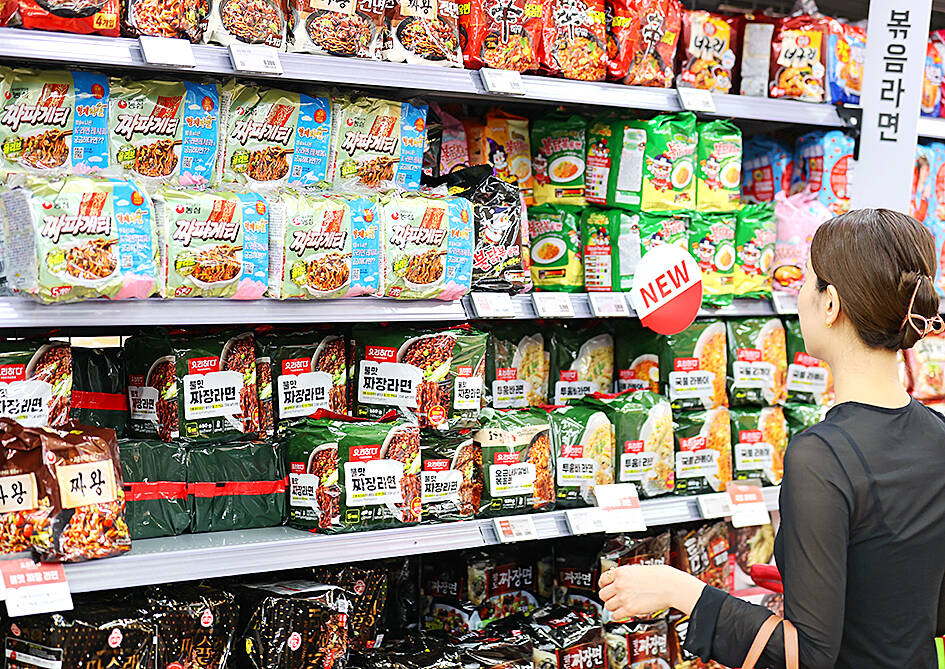Spicy tomato, seafood, teriyaki chicken, Korean barbecue, cheese curry. Or for those with a gargantuan appetite, an “American breakfast” — all served in a pot along with a block of air-dried noodles.
When Momofuku Ando invented insutanto ramen in his back yard shed in Osaka 65 years ago, he could have had little inkling that the simple, starchy convenience food would become a global food staple.
Ando, who died in 2007 aged 96, lived long enough to see the firm he founded, Nissin Foods, make successful forays into the international market with versions that cater to people with religion-based dietary requirements and incorporate local tastes.

Photo: EPA-EFE
Following the global appetite for regular ramen — seen in the spread of famous Japanese chains to the streets of New York and London, and the long queues of tourists outside shops in Tokyo — its pre-packaged cousin is now at the forefront of a second ramen boom.
Last year, consumers in more than 50 countries slurped their way through a record 121.2 billion servings of instant noodles, according to the Osaka-based World Instant Noodles Association.
Countries with a long history of eating noodles were predictably high on the consumption table, led by China and Hong Kong, and Indonesia. Vietnam and Japan ranked fourth and fifth, but third spot was taken by India, in a sign of the food’s growing popularity in countries that many people do not immediately associate with eating noodles.
SOARING DEMAND
In Mexico, demand soared by 17.2 percent in 2021 — when many people turned to instant noodles during COVID-19 restrictions — but still rose by 11 percent last year. The US, too, has followed up on its healthy appetite for regular ramen to embrace the instant variety, in part to relieve pressure on household finances from the cost-of-living crisis.
“Middle-class consumers who did not eat instant noodles before are now incorporating them into their daily lives” the Japanese instant noodle giant, Nissin Foods, said, according to the Nikkei business paper.
As a result, Nissin and rival Toyo Suisan, recently announced the construction of production facilities in the US and Mexico by 2025 to meet soaring demand.
“The number of consumers who regularly eat instant noodles is going up, and we will increase our variety of flavors,” Toyo Suisan said in a statement to the Nikkei.
Nissin said this month it would spend US$228 million on expanding its presence in the US, including a new factory in South Carolina to add to its existing plants in California and Pennsylvania.
“Nissin Foods has seen sustained sales growth year-over-year, especially over the last five years, driven by unprecedented demand for our products,” Nissin Foods president in the US, Michael Price, said in a statement.
According to the Nissin group philosophy as handed down by Ando: Peace will come to the world when there is enough food. Peace has proved elusive, but more of the world is tucking into his invention.
The result of Ando’s eureka moment first appeared on the market in August 1958 as Chikin (chicken) Ramen and was sold in a cellophane pack. The noodles were cooked, then “watered” with chicken soup, seasoned and deep-fried in palm oil to dehydrate them. Although they initially cost more than the fresh variety, they could be cooked in just three minutes and eaten at home. After a successful year of gauging consumer reaction in the Osaka area, Chikin Ramen were unleashed on noodle lovers nationwide.
‘GLOBAL FOOD’
Decades later, they have become a genuine “global food,” according to Ichiro Yamato, an instant ramen expert who sells a wide range of noodles at his shop in Osaka.
“If you look at postwar history, it’s clear that when the workforce expands, consumption of instant noodles also rises,” said Yamato, who eats instant ramen once a day. “It happened in Japan during the postwar economic miracle, when the workforce grew and baby boomers started eating instant ramen and giving them to their children.”
While few foods in Japan have escaped price rises during the cost-of-living crisis — the price of instant ramen has increased 20 percent in the past two years — noodles in cups and packets are still considered a cheap, if nutritionally dubious, source of sustenance.
The Japanese ate just under 6 billion servings of instant noodles last year, according to the Japan Instant Food Industry Association, continuing a trend that began with the arrival of Cup Noodle — shorter noodles in a Styrofoam cup — in 1971 and, later, the proliferation of convenience stores. About 1,000 new versions are dangled before Japanese consumers every year, according to Yamato, but only a handful survive in a crowded, cut-throat market.
On a recent afternoon, parties of schoolchildren and tourists learned about instant ramen’s evolution at the Cupnoodles Museum in the Osaka suburb of Ikeda, the food’s birthplace. Rows of packages spanning more than six decades adorn the walls and ceilings, while the museum’s 900,000 annual visitors can make their own bespoke versions of Nissin’s signature Cup Noodle, more than 50 billion units of which have been sold worldwide since its launch in the early 1970s.
TAIWAN CONNECTION
Born in Japanese-ruled Taiwan in 1910, Ando founded the predecessor to Nissin in 1948. But had he listened to his colleagues, the ubiquitous Cup Noodle might never have made it on to supermarket shelves: researchers dismissed his recipe as “fanciful,” but Ando refused to be deterred.
Yamato attributes the global appetite for what was once a go-to snack for hard-up students to manufacturers’ focus on local culinary tastes, whether it is the halal versions sold in Indonesia and other countries with large Muslim populations, or the addition of familiar flavors, such as nam pla fish sauce in Thailand, garam masala in India and champignon — mushrooms — in France.
While manufacturers continue to expand overseas, Japan will remain a lucrative base, said Yamato, 55, who has eaten 25,000 servings of instant noodles since he was a schoolchild.
“We’re seeing a move towards retro packaging that makes people feel nostalgic,” he said, noting that designs featuring Japanese kanji [LINK] characters had proved a hit. “Worldwide, instant noodles can only get bigger, led by India and countries in Africa and Asia with young, growing populations.”
The connoisseur says he has developed a taste for a new range of thicker instant noodles, which he eats with a topping of fresh vegetables. The American breakfast variety, however, is unlikely to “come home” to Japan from the US, where it went on sale earlier this year.
“It’s a mixture of maple syrup, pancakes, sausages and egg,” said Yamato, who tried the concoction during a recent visit to the US. “I have to say, they weren’t really for me.”

Taiwanese chip-making giant Taiwan Semiconductor Manufacturing Co (TSMC) plans to invest a whopping US$100 billion in the US, after US President Donald Trump threatened to slap tariffs on overseas-made chips. TSMC is the world’s biggest maker of the critical technology that has become the lifeblood of the global economy. This week’s announcement takes the total amount TSMC has pledged to invest in the US to US$165 billion, which the company says is the “largest single foreign direct investment in US history.” It follows Trump’s accusations that Taiwan stole the US chip industry and his threats to impose tariffs of up to 100 percent

On a hillside overlooking Taichung are the remains of a village that never was. Half-formed houses abandoned by investors are slowly succumbing to the elements. Empty, save for the occasional explorer. Taiwan is full of these places. Factories, malls, hospitals, amusement parks, breweries, housing — all facing an unplanned but inevitable obsolescence. Urbex, short for urban exploration, is the practice of exploring and often photographing abandoned and derelict buildings. Many urban explorers choose not to disclose the locations of the sites, as a way of preserving the structures and preventing vandalism or looting. For artist and professor at NTNU and Taipei

March 10 to March 16 Although it failed to become popular, March of the Black Cats (烏貓進行曲) was the first Taiwanese record to have “pop song” printed on the label. Released in March 1929 under Eagle Records, a subsidiary of the Japanese-owned Columbia Records, the Hoklo (commonly known as Taiwanese) lyrics followed the traditional seven characters per verse of Taiwanese opera, but the instrumentation was Western, performed by Eagle’s in-house orchestra. The singer was entertainer Chiu-chan (秋蟾). In fact, a cover of a Xiamen folk song by Chiu-chan released around the same time, Plum Widow Missing Her Husband (雪梅思君), enjoyed more

Last week Elbridge Colby, US President Donald Trump’s nominee for under secretary of defense for policy, a key advisory position, said in his Senate confirmation hearing that Taiwan defense spending should be 10 percent of GDP “at least something in that ballpark, really focused on their defense.” He added: “So we need to properly incentivize them.” Much commentary focused on the 10 percent figure, and rightly so. Colby is not wrong in one respect — Taiwan does need to spend more. But the steady escalation in the proportion of GDP from 3 percent to 5 percent to 10 percent that advocates